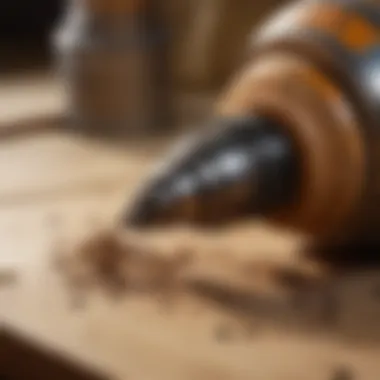Unveiling the Ultimate Rotary Tool for Precision Wood Carving


When delving into the realm of wood carving, selecting the right rotary tool is crucial for achieving precision and finesse in your craft. This comprehensive guide aims to equip woodworking enthusiasts with the intricate knowledge needed to make an informed choice tailored to their specific needs and preferences.
Understanding Key Features and Considerations
Before embarking on your journey to find the best rotary tool for wood carving, it is essential to grasp the fundamental features that distinguish one tool from another. From motor power to variable speed settings, ergonomic design, and versatility in attachments, each aspect plays a pivotal role in optimizing your woodworking experience.
Comparing Various Models
Navigating the myriad of rotary tool models available in the market can be overwhelming. Through detailed comparisons of different brands, such as Dremel, Wen, and Tacklife, enthusiasts can gain insight into performance, durability, pricing, and compatibility with various carving projects. Understanding the strengths and weaknesses of each model is paramount in honing in on the perfect tool.
Sourcing the Ideal Tool for Woodworking Enthusiasts
Woodworking enthusiasts are diverse in their requirements and preferences when it comes to choosing a rotary tool. Whether prioritizing precision for intricate detailing or power for larger-scale projects, this guide aims to cater to a wide range of needs. By dissecting the nuances of each model and presenting real-world applications, readers can make an informed decision that aligns with their woodworking aspirations.
Elevating Woodcarving Craftsmanship
The significance of selecting the best rotary tool for wood carving goes beyond mere functionality; it impacts the quality and artistry of the final creations. By investing time and effort in understanding the intricacies of various models, enthusiasts can elevate their woodworking craftsmanship to new heights, achieving unparalleled precision and creativity in their projects.
Delving Deeper into Specialized Techniques
Beyond the technical specifications and features, wood carving encompasses a world of specialized techniques that can only be fully realized with the right rotary tool. From relief carving to whittling and everything in between, each style demands a specific set of tools and attachments for optimal results. This guide delves into the intimate link between technique and tool, illuminating the path to mastery in wood carving.
Conclusion: The Quest for Woodworking Excellence
Introduction
Wood carving, a revered craft that blends creativity with precision, demands the finest tools to bring visions to life. In this insightful guide, we delve into the intricacies of selecting the best rotary tool for wood carving, a pivotal decision for woodworking enthusiasts. From understanding the nuances of rotary tools to comparing top models, this article aims to equip artisans with the knowledge needed to elevate their craft to new heights.
Understanding Rotary Tools


Rotary tools embody versatility and precision, catering to a wide array of woodworking tasks. The subheadings 'Different types of rotary tools' and 'Applications in wood carving' shed light on the core aspects of these instruments.
Different types of rotary tools
In the realm of rotary tools, a myriad of options exists, each tailored to specific carving needs. From handheld rotary tools to stationary rotary machines, woodworkers can choose based on the intricacy and scale of their projects. While handheld rotary tools offer maneuverability and ease of use, stationary machines boast power and stability essential for large-scale carving endeavors. Understanding the benefits and drawbacks of each type is crucial for selecting the ideal tool that aligns with individual crafting styles.
Applications in wood carving
Wood carving stands as a prominent application of rotary tools, allowing artisans to sculpt intricate designs with unparalleled precision. Whether shaping intricate details or smoothing rough surfaces, rotary tools enhance the artist's ability to bring imagination to reality. Despite their versatility, users must exercise caution to avoid mishaps and ensure safety throughout the carving process.
Key Features to Consider
When selecting the best rotary tool for wood carving, it is crucial to consider key features that will enhance your woodworking experience. One of the most vital aspects to ponder is the power and speed capabilities of the tool. Power plays a significant role in carving as it determines the tool's ability to cut through various types of wood effortlessly. Opting for a rotary tool with sufficient power ensures smoother and more precise cuts, making intricate designs more manageable. Moreover, high power also enables you to work on dense or hardwoods without stalling or overheating.
Additionally, focusing on the speed settings of the rotary tool is essential. Different wood carving tasks require varying speed levels for optimal results. Having the flexibility to adjust the speed according to the specific wood type or carving technique being employed is advantageous. Lower speeds are ideal for delicate detailing work, while higher speeds are more suitable for shaping and roughing out the wood. A rotary tool with variable speed settings allows for versatility in executing diverse woodworking projects with precision and control.
Considering power and speed features while choosing a rotary tool ensures efficiency, accuracy, and ease of use in wood carving endeavors.
Power and Speed
Importance of power in carving
The significance of power in carving lies in its ability to determine the cutting performance and efficiency of a rotary tool. A higher power rating indicates the tool's capability to handle tough materials and intricate designs with ease, reducing the likelihood of the tool bogging down or struggling during operation. Enhanced power ensures smoother carving motions and quicker material removal, making the carving process more efficient and enjoyable. Opting for a rotary tool with ample power enables woodworkers to tackle a wide range of carving tasks effectively, from shaping to detailing, without compromising on precision.
Optimal speed settings for wood
The optimal speed settings for wood carving are paramount in achieving desired results and maintaining control over the carving process. Different wood types and carving techniques require specific speed levels to ensure clean cuts and accurate shaping. With adjustable speed settings, woodworkers can tailor the rotary tool's RPM (Revolutions Per Minute) to suit the task at hand, whether it involves intricate detail work or rough shaping. Lower speeds promote precision and finesse in carving, while higher speeds facilitate quicker material removal and shaping. By selecting the appropriate speed setting for each carving stage, woodworkers can enhance the quality of their work and achieve professional-level results in wood carving projects.
Choosing the Right Accessories
Types of Bits and Attachments


Carving Bits for Intricate Designs
When delving into wood carving, the selection of carving bits plays a pivotal role in bringing intricate designs to life. Carving bits are specifically designed to carve out detailed patterns and intricate shapes with precision. Their key characteristic lies in their ability to create fine lines and unique textures, enhancing the aesthetic appeal of woodwork. In this article, the focus on carving bits for intricate designs underscores their popularity among wood carving enthusiasts for their precision and exceptional detailing capabilities. The unique feature of carving bits lies in their versatility, allowing woodworkers to explore diverse design possibilities while maintaining accuracy. However, it is essential to note that the intricate nature of carving bits may require a certain level of skill and practice to master effectively, making them a choice that prioritizes precision and attention to detail.
Sanding Attachments for Finishing
In the realm of wood carving, sanding attachments play a crucial role in perfecting the finishing touches of your woodworking projects. These attachments are specifically tailored to smoothen out rough edges, refine surfaces, and achieve a polished final look. The key characteristic of sanding attachments lies in their ability to deliver a professional finish, enhancing the overall quality of the carved wood. Their popularity stems from the efficiency and precision they offer in refining details and achieving a smooth texture. The unique feature of sanding attachments is their versatility in catering to various wood types and finishes, making them a valuable asset in woodworking. However, it is important to note that the use of sanding attachments requires careful handling to prevent over-sanding or damage to the wood surface. Hence, while sanding attachments excel in providing a flawless finish, proper technique and control are essential to ensure woodwork perfection.
Comparing Top Rotary Tools
In the realm of woodworking, the comparison of top rotary tools holds significant value in identifying the optimal instrument for wood carving endeavors. The differentiation between various rotary tools lies in their technical specifications, performance metrics, and overall durability. By scrutinizing and contrasting these aspects, woodworking enthusiasts can make informed decisions when selecting the most suitable tool for their projects.
When comparing top rotary tools, key elements to consider include power output, speed settings, ergonomics, and versatility in handling different wood types. Understanding the nuanced differences between various models helps users pinpoint the tool that aligns best with their specific carving requirements and preferences. By delving into the intricacies of each rotary tool's design and functionalities, users can ascertain which model offers the ideal balance of performance and durability for a seamless wood carving experience.
Model A: Performance and Durability
Technical Specifications
Digging into the technical specifications of Model A unveils a high-powered motor, capable of delivering precise and efficient carving performance. The wattage output of the motor significantly impacts the tool's carving speed and cutting precision, making it a preferred choice for woodworking aficionados seeking professional-grade results. Additionally, the ergonomic design of Model A enhances user comfort during prolonged carving sessions, reducing fatigue and ensuring optimal control over intricate carving tasks.
Unveiling the unique feature of Model A's technical specifications, its variable speed control mechanism enables users to customize cutting speeds according to the wood density and carving intricacy. This feature not only enhances the tool's versatility but also contributes to its suitability for a wide range of wood carving applications. While the technical specifications of Model A present a formidable option for wood carvers, it is essential to consider the power consumption and maintenance requirements associated with this high-performance tool.
User Feedback
Exploring user feedback provides valuable insights into the practical application of Model A in real-world woodworking scenarios. Users commend the durability of Model A, citing its robust construction and longevity as standout features that ensure long-term usability and consistent performance. The ergonomic design of the tool also garners praise from users, highlighting its comfortable grip and user-friendly controls as contributing factors to a positive carving experience.
User feedback underscores the high level of precision and accuracy achievable with Model A, emphasizing its suitability for intricate wood carving tasks that demand meticulous attention to detail. However, some users note potential drawbacks related to noise levels and vibration during operation, indicating areas for further enhancement in future iterations of the tool. Overall, user feedback underscores the performance and durability aspects of Model A, solidifying its position as a top contender in the realm of rotary tools for wood carving.
Best Practices for Wood Carving


Wood carving is a delicate craft that demands precision and attention to detail. In this section of the guide, we will delve into the essential best practices that every wood carver should adhere to in order to ensure a safe and successful carving experience. These best practices serve as the foundation for mastering the art of wood carving and can significantly enhance the quality of your projects. By understanding and implementing these practices, woodworkers can elevate their skills and create stunning masterpieces with confidence.
Safety Guidelines
Wearing Protective Gear
When engaging in wood carving, wearing proper protective gear is paramount to ensuring personal safety and preventing accidents. Protective gear such as safety goggles, dust masks, and gloves shield carvers from potential hazards like wood particles, flying debris, and sharp tools. This precaution not only safeguards the carver's well-being but also promotes a conducive and secure working environment. The careful selection of protective gear that suits the specific needs of wood carving is crucial for a smooth and secure carving process. While some may find wearing protective gear cumbersome, its invaluable protection and peace of mind make it a wise and practical choice for any wood carving enthusiast.
Securing Workpieces
Another critical aspect of wood carving is securing workpieces effectively during the carving process. Properly securing the wood piece prevents it from slipping, rotating, or moving unexpectedly, which can result in imprecise cuts or potential injuries. Various methods can be employed to secure workpieces, such as clamps, bench hooks, or workbenches, depending on the size and shape of the wood being carved. Securing workpieces not only enhances the quality and accuracy of carving but also minimizes the risk of accidents and ensures a more controlled carving environment. By prioritizing the stability and immobilization of workpieces, wood carvers can focus on honing their carving skills and achieving impeccable results.
Conclusion
Within the realm of woodworking, the craftsmanship involved hinges on the precision and efficiency of the tools used. By comprehensively understanding the key features, nuances, and intricacies of rotary tools catered specifically for wood carving, artisans and hobbyists alike can elevate their woodworking game to new heights. Through a meticulous comparison of various models, discerning individuals can pinpoint the perfect tool that aligns with their unique needs and preferences, ensuring optimal performance and durability for their carving endeavors.
Wood carving, as an art form, demands attention to detail, precision, and safety. By adhering to best practices and safety guidelines highlighted within this guide, users can safeguard themselves against potential risks while maximizing their creative potential. Whether it's donning protective gear or securely fastening workpieces, every step taken in alignment with safety protocols plays a crucial role in the overall wood carving experience.
The essence of this article lies in equipping woodworking enthusiasts with the knowledge and insights necessary to navigate the intricate world of rotary tools for wood carving effectively. By synthesizing the information presented throughout, readers gain a holistic view of the factors influencing tool selection and usage, empowering them to make informed decisions that enhance their craft and artistic endeavors.
Final Thoughts
Summarizing key points
Delving into the crux of summarizing key points, we unravel the significance of consolidating crucial information for woodworking enthusiasts embarking on their journey of selecting the ideal rotary tool for wood carving. Summarizing key points not only aids in distilling complex concepts into digestible chunks but also serves as a compass guiding users through the plethora of features and considerations discussed within this guide.
The beauty of summarizing key points lies in its ability to encapsulate essential details, serving as a reference point for users to revisit and reinforce their understanding of the nuances driving rotary tool selection for wood carving. By emphasizing clarity and coherence in summarizing key aspects, readers can streamline their decision-making process, leading to informed choices that align with their woodworking objectives.
Highlighting the user-friendly nature of summarizing key points, enthusiasts can effortlessly navigate through the wealth of information presented within this article, facilitating a seamless journey towards expertise in rotary tool selection for wood carving.
Emphasizing importance of tool selection
Shifting focus towards emphasizing the importance of tool selection within the realm of wood carving, we underscore the pivotal role that choosing the right rotary tool plays in shaping the outcomes of woodworking projects. The essence of craftsmanship lies not only in skill but also in the precision and efficiency afforded by the tools at hand, making tool selection a critical determinant of success in wood carving endeavors.
Flaunting a keen emphasis on quality, durability, and performance, the importance of tool selection resonates deeply with woodworking enthusiasts seeking tools that can withstand the rigors of intricate carving work. By pairing skill with the right tool, artisans can seamlessly bring their creative visions to life, infusing their creations with a touch of finesse and artistry that sets them apart within the woodworking community.
From precision cutting to intricate detailing, the emphasis on tool selection transcends mere functionality, delving into the realm of artistry where the right tool becomes an extension of the artisan's creativity and vision. Crafting masterpieces in wood carving necessitates a judicious approach to tool selection, ensuring that each stroke and carve embodies the essence of precision and passion inherent within woodworking craftsmanship.







